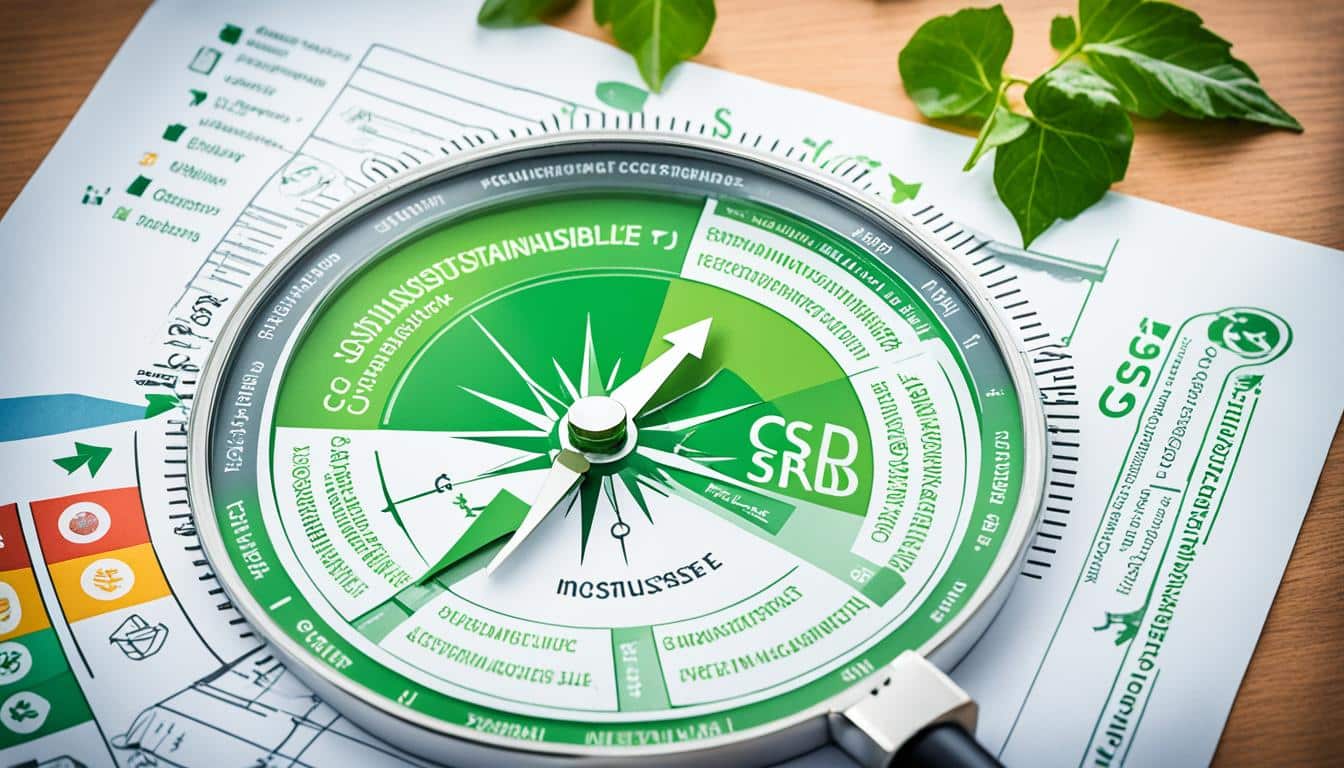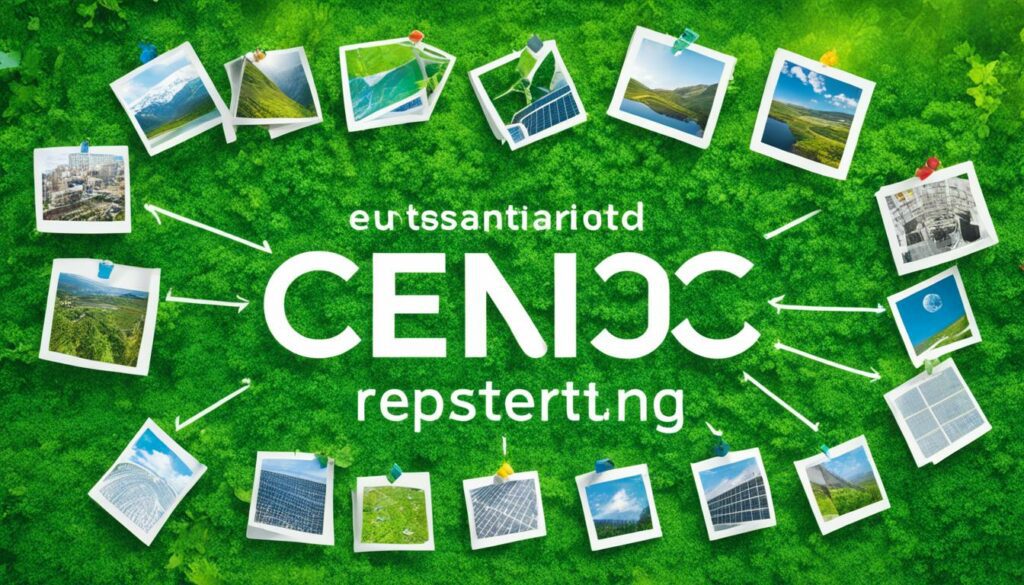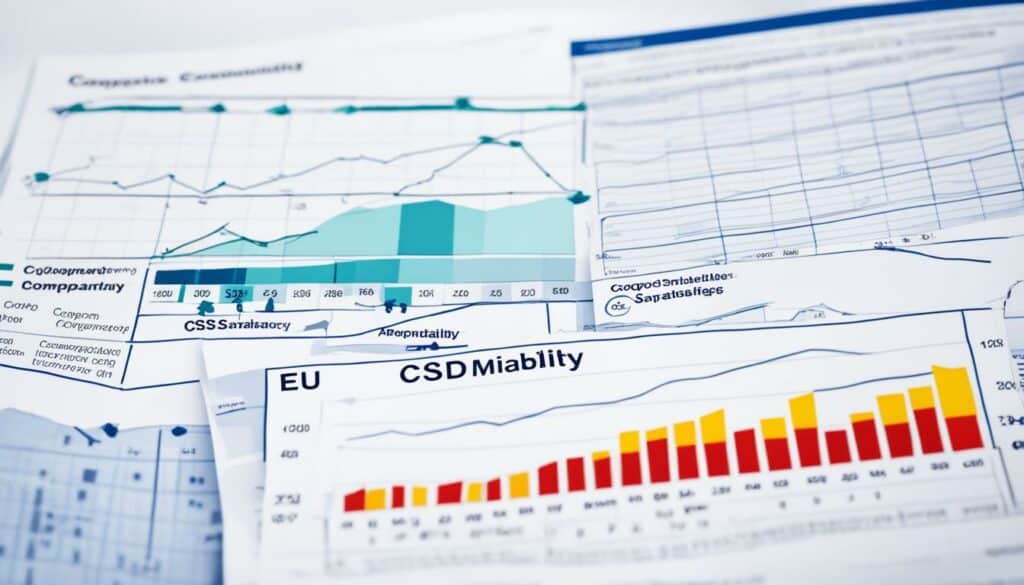Menu

Did you know that the Corporate Sustainability Reporting Directive (CSRD) includes more companies now? It went from affecting 11,000 companies to nearly 50,000. The change shows how serious the European Union is about making companies tell us more about their corporate social responsibility reporting and sustainability efforts. The CSRD, started on 5 January 2023, makes companies share how they do on things like helping the environment and being fair to people.
The CSRD now looks at more than just big companies in Europe. It also checks up on companies from outside the EU that do a lot of business here. Starting in 2026, even small and medium-sized companies from Europe will need to follow strict rules when they report on their green and fair actions. The rules focus on many important things, like how companies handle pollution, water, and waste. This way, the CSRD makes sure companies are open about the ways they help or harm the planet and people.
The CSRD is such a big deal that it’s expected to change how companies all around the world work on being more green and fair. So, even if a company is not based in the EU, if it does business here, it must follow these new rules. This affects companies globally, making the CSRD an important issue for anyone doing business with the EU. Countries like Japan will need to pay attention to these new rules from 2026 to 2029.
The EU Corporate Sustainability Reporting Directive (CSRD) started on 5 January 2023. It changes how companies report their sustainability efforts. Now, businesses in and outside the EU must show how they look after the environment and society if they earn over EUR 150 million in the EU.
Companies have to follow the European Sustainability Reporting Standards (ESRS). EFRAG introduced these standards in the Official Journal on 22 December 2023. This makes sure all reports are done the same way. It helps investors and others understand a company’s role in the world and any financial risks connected to sustainability.
The CSRD joins sustainability reports with their yearly financial updates. This makes sure companies’ eco, social, and governance work is checked more. The link improves how companies report meets financial and strategic plans.
First CSRD reports come in the 2024 money year. They need to be published in 2025. This deadline pushes companies to get ready for detailed and ongoing sustainability checks.
The CSRD helps cut the costs of reporting over time by asking for the same details from everyone. This helps both reporting companies and those who use the reports for decisions.
Adding on, the CSRD asks for an independent check on the sustainability reports. This makes the information more trustworthy and accurate. Plus, it includes using digital ways to manage the data better.
The EU Corporate Sustainability Reporting Directive (CSRD) has expanded its reach. Now, it includes more entities, totaling nearly 50,000. This affects both big companies and small and medium enterprises (SMEs) inside the EU. Non-EU companies that have a big presence in the EU also fall under the directive.

For large companies, certain thresholds must be met to qualify. These include a net turnover of €40 million or more, assets above €20 million, or a staff count of at least 250. They need to share detailed reports on their social and environmental impacts. They should follow the European Sustainability Reporting Standards (ESRS), outlined in the Official Journal on 22 December 2023.
Starting with the 2024 financial year, large companies need to report sustainability information. This rule includes non-EU companies that make over EUR 150 million in the EU market. The goal is to make reporting more consistent. Then, over the medium to long term, this should lower costs by using standard digital methods and assurance frameworks.
SMEs on regulated markets must also follow some of the CSRD’s rules. But they have simpler requirements, which start in January 2026. This adds SMEs to the effort to improve transparency and sustainability. It ensures that everyone follows the same rules, making reporting easier and more useful for everyone involved.
As SMEs get ready to meet the CSRD standards, they will do it step by step. This is part of a plan to increase corporate sustainability in all business sizes and types. In the end, the CSRD’s wider coverage leads to a stronger and more complete sustainability reportage in the EU.
The CSRD timeline shows a step by step plan from 2024 to 2028. This is as the EU’s new rules on sustainability reporting are put into place. In May 2022, people gave their thoughts on the EFRAG’s early standards. This was an important step before the standards were finalised.
In November 2022, the European Parliament agreed to the CSRD. This means companies with 500 or more workers and listed in the EU will have to report from 2025. They start with data from the beginning of 2024.
After this, all large firms, including those making more than €250 million, must fully follow the rules by 2025.
The important steps ahead include:
Around 50,000 companies in Europe need to follow the new rules on sustainability. This covers both big and small companies. Even some with less than 750 workers can skip a few reports at first. This is to help them manage the new process. It’s all part of a careful plan towards more detailed sustainability reporting. This plan follows the EFRAG’s guidelines to help companies adjust step by step.
The EU Corporate Sustainability Reporting Directive (CSRD) puts big demands on companies. It asks them to be open and responsible, especially about their environmental and social effects. These new rules mean firms have to report both their financial and green or ethical actions. This helps investors and the public see the full picture of a company’s success.
The heart of the CSRD is the European Sustainability Reporting Standards (ESRS). These standards are very detailed, ensuring all companies report their green and ethical efforts in the same way. The European Financial Reporting Advisory Group (EFRAG) carefully made the ESRS. They cover 12 areas, like how companies use energy, treat their staff, and run their business.
The ESRS work with other big reporting systems, such as the TCFD and GRI. This makes sure all reports, wherever they come from, look similar. Such standardisation is key for global transparency.

Companies must now share a lot more information than before. They have to talk about how they use the environment and communities around them. This means telling people about their pollution levels, water use, and how they manage waste. They must also share their plans for protecting nature and stopping pollution.
This extra reporting helps show the full story of what companies are doing for the planet and society. It’s not just about their products and sales anymore. The CSRD means they must show exactly how they’re making the world a better place.
Thanks to the CSRD, soon companies will have to mix up their profit numbers with eco and social facts in one report. This one big report will give everyone, from shareholders to the local community, a clear view. They’ll see not only how much money a company is making but also find out about its effects on the world. This approach is vital for a true understanding of a firm’s work.
This new way of reporting is called “double materiality.” It means firms must think about how their actions affect both their profit and the world. So, companies will need to balance making money with being good for the planet and people.
The CSRD also requires firms to get their green and fair work checked by an outside expert. This check aims to keep the information accurate and trustful. An independent third-party must make sure the reports follow the ESRS rules and are true.
By July 2024, all EU countries must make sure their companies follow the CSRD. The first reports will come out in 2024. This gives businesses time to get ready for the new rules. They must aim to fully follow the CSRD, showing they’re looking after our planet and communities well.
The Corporate Sustainability Reporting Directive (CSRD) requires a double materiality assessment. Companies must look at both their sustainability impacts and financial outcomes. This ensures they fully comply with the CSRD.
Companies must look deep into how their actions affect society and the planet. They check the scale, scope, and how some impacts can’t be fixed. They also consider the chances of these impacts happening.
Any harm to the environment or people should be openly reported and dealt with. They must talk to everyone involved, from employees to community groups, to understand what really matters.
| Aspects | Key Considerations | Stakeholders Involved |
|---|---|---|
| Scale | Magnitude of impact | Regulators, NGOs |
| Scope | Geographical and functional breadth | Community organizations, suppliers |
| Irremediability | Degree of impact that is irreversible | Civic groups, environmental bodies |
| Likelihood | Probability of occurrence | Risk management teams, executive leadership |
Financial materiality focuses on how sustainability can affect a company’s money. This looks at possible changes in revenue, spending, and investment cost. The European Financial Reporting Advisory Group (EFRAG) gives guidance for a standard approach. Companies need to work together internally, including financial and risk teams. They must make sure their processes follow CSRD. Important money metrics are studied to see the effect. This helps companies combine their financial roles with looking out for the environment.
“By engaging in thorough double materiality assessments, corporations can better understand the intertwined relationship between financial health and sustainability, ensuring they meet both fiduciary and social responsibilities,” states Cassandra Garber, VP of Corporate Sustainability & ESG at Dell Technologies.
In summary, the dual view required by the double materiality under the CSRD helps companies fully see their impacts and their financial results. This approach is key to giving honest and clear reports about their environmental and social effects.
The EU’s Corporate Sustainability Reporting Directive (CSRD) orders companies to share detailed facts about their ESG behaviour. This makes companies tell their story fully. They lay out how they affect things around them.

For environmental reports, the CSRD wants info on things like climate change and waste. Companies need to talk about their carbon footprint and how they’re tackling it. They do this following the European Sustainability Reporting Standards (ESRS).
In terms of social reports, efforts on human rights and community relationships matter. Businesses must show how they treat their people fairly. They also show how they promote inclusivity. Social reports are about sharing the good they’re doing for society.
Governance reports focus on how companies are run. This includes details on board members, ethics, and being open. The goal is to show the company is being responsible and ethical in its decisions.
The CSRD demands thorough ESG reports. This helps investors and others understand how a company is doing in caring for the planet and people.
European Financial Reporting Advisory Group (EFRAG) has been key in setting EU sustainability reporting standards. This is part of the Corporate Sustainability Reporting Directive (CSRD). The European Commission asked EFRAG to create non-financial reporting standards on 25 June 2020.
EFRAG formed a Project Task Force (PTF-NFRS) with the help of the European Lab. It had people from various sectors in the EU. This team ensured the standards were broad and fair.
On 6 November 2020, the PTF-NFRS gave the European Commission an early report and advice. From 13 to 22 January 2021, they also had talks with stakeholders to get feedback on early ideas.
EFRAG’s work ended with a final report on 28 February 2021. The report had a clear plan for using the new EU standards. Then, on 8 March 2021, they published the PTF-NFRS final report and suggested ways to improve how things are managed.
On 21 April 2021, the European Commission made a proposal for the CSRD to be law. Companies will have to follow the new European Sustainability Reporting Standards (ESRS). Shortly after, on 12 May 2021, Commissioner McGuinness said we need to start working on this quickly. He agreed with Jean-Paul Gauzès that we need changes to how things are managed.
Overall, EFRAG’s hard work has really helped with the EU’s sustainability reporting. They make sure the CSRD’s rules are clear and the same for everyone. This helps improve report quality across the EU.
The Corporate Sustainability Reporting Directive (CSRD) asks firms to mix their sustainability info into usual financial reports. This should give a full view of a company’s work, both on money and non-money activities. Thus, it helps everyone understand how well a company is doing.

Under CSRD, companies need to make their sustainability info clear and separate. This makes it easier to connect with how they’re doing financially. They must use a certain format that matches the ESEF rules. This helps meet European standards and makes the data easy to understand.
The CSRD insists that sustainability info links with the usual financial data. This way, the reports cover eco-measures and resource use in the finances. It gives everyone a bigger picture of a company’s impact.
This helps investors and others check risks and chances about the company’s future. It shows how financial and green efforts go hand in hand. This way, people can get a better picture of the company’s overall position.
Companies face several hurdles when it comes to the Corporate Sustainability Reporting Directive (CSRD). One main issue is interpreting the European Sustainability Reporting Standards (ESRS). The European Financial Reporting Advisory Group (EFRAG) has cut the required disclosures by almost half. This simplification helps a bit. But firms still tackle challenging standards that remain.
Getting reporting standardisation is key. The latest ESRS lets companies choose some data points rather than be forced to report on them. This flexibility helps. Still, companies work hard to blend new rules with their old ways.
Handling sustainability data collection poses a big challenge too. Around 50,000 European firms are subject to the CSRD. They face a huge load of data to collect, covering various topics in depth. Knowing what data matters, how to gather it, and making sure it’s right is crucial but tough.
Dealing with certified data adds more complexity. In France, data for the CSRD must be checked by an auditor or ITPO. This extra step needs extra care and time to meet.
Firms also need to keep up with rule changes. The CSRD’s thresholds are now aligned with inflation. Companies must not ignore these updates. Not following the CSRD can lead to fines and losing trust from those who rely on them. So, firms must face these obstacles head-on.
The success of the Corporate Sustainability Reporting Directive (CSRD) relies on getting data right. Companies need to collect lots of information about their impact on the environment. This follows strict CSRD data requirements. It’s important to know that the CSRD will roll out in four steps, starting in 2024. It will focus on big businesses in the U.S. that work in EU markets and have over 500 people.

The CSRD now includes about 50,000 EU companies and over 3,000 from the U.S. These firms must meet the directive’s tough rules. This means they need a top-notch sustainability data management setup. Companies with a net turnover of more than €50 million EUR or over 250 staff have to report. The same goes for those with assets surpassing €25 million EUR.
Collecting data is closely linked to the EU Taxonomy. It makes companies share how they’re doing in areas like fighting climate change and moving to circular economy models. Keeping data accurate and detailed is key to being open and honest about a company’s environmental and social impacts.
Data for the CSRD also helps with other laws, like the Sustainable Finance Disclosure Regulation (SFDR). This one makes finance companies show how green their products are. So, getting and managing data well is not just about following rules. It’s a chance for businesses to organize their environmental reports better. This improves how trustworthy they seem to others.
Embracing reporting standardisation means using the same sustainability rules. This makes it easy for everyone to understand the data companies share. It helps with making smart choices for the future.
To succeed in aligning reporting frameworks, we must see what makes each rule special. The European Sustainability Reporting Standards (ESRS) show us how to connect with other big frameworks. This makes global sustainability reporting work well together.
The CSRD wants companies to talk about social and environmental issues. Think climate change and protecting nature. By using the same rules, companies can share information better. They won’t repeat things and will make their reports clearer.
| Framework | Key Focus Areas | Alignment Strategy |
|---|---|---|
| CSRD | Social and environmental issues | Develop ESRS for comprehensive integration |
| GRI | Global sustainability standards | Ensure consistency in ESG metrics |
| TCFD | Climate-related financial disclosures | Incorporate climate risk assessments |
Getting everyone to report the same is not just a box-ticking job. It’s about making real improvements. With the CSRD, using ESRS helps companies tell their sustainability stories better. It makes reporting more useful and interesting.
The Council of the European Union brought in the Corporate Sustainability Reporting Directive (CSRD) in November 2022. This was a big step for sustainability report auditing. The CSRD now looks at 50,000 firms, including those outside the EU. This reflects Europe’s strong support for the European Green Deal.

Now, large U.S. companies with over 500 employees listed in the E.U. need independent assurance from 2024. This covers the quality and trust in their sustainability reports. It makes sure their nonfinancial details are regular, fit for purpose, and can be compared.
Before, doing an external check was a choice. But the CSRD makes it a must to have an outside expert look at reports. At first, companies will only need a simple check, then a deeper look as time goes on. This means reports are thoroughly checked to please everyone involved.
Experts can check at two levels, either lightly or deeply, with the ISAE3000 rules. The deep check makes sure everything’s in line with strict laws. Internal checks help companies themselves check off rules, making sure they follow every step correctly.
Companies have a three-year period to improve how they collect important data. This is key to do their sustainability reports right. Those in the finance industry need to look at more transparency rules too, to match the EU’s green goals.
Everyone is affected by these new rules. Not just those in the EU but also those from elsewhere. This shows these rules make the whole world think and act more about sustainability. Working together, companies and checkers from the EU or not, is very important for the success of these new rules.
| CSRD Phases | Entities Affected | Assurance Level |
|---|---|---|
| 2024 | Large U.S. Companies Listed in EU | Limited Assurance |
| 2025 | All Other Large Undertakings | Reasonable Assurance (Future) |
| 2028 | Non-EU Headquartered Companies | Reasonable Assurance (Expected) |
Meeting the CSRD audit rules is crucial. It ensures sustainability reports are trustworthy. Companies need to focus on this to keep their promises honest.
The Corporate Sustainability Reporting Directive (CSRD) changes how companies report their efforts in sustainability. It creates chances for companies to become more transparent and credible. This shift helps the market see them as trustworthy organisations.
Following the CSRD helps firms show clear transparency in what they do for the planet. They share detailed information about their environmental, social, and governance practices. This makes stakeholders, like investors and consumers, trust them more. The directive also asks for details about all business relationships. This broad look at a company’s impact and ethics builds its trustworthiness. It shows a company is committed to being sustainable and ethical worldwide.
The CSRD gives companies the chance to improve how they work with stakeholders. Openness in reporting helps build trust and show responsibility to investors and partners. Companies report on how their operations and wider world are affected by sustainability issues. This approach can boost how well they connect with stakeholders. It encourages teamwork for a sustainable future.
| Key Benefits | Description |
|---|---|
| Enhanced Transparency | Provides a full view of the company’s ESG practices, fostering credibility and trust. |
| Corporate Credibility | Positive perception among stakeholders as a responsible and sustainable enterprise. |
| Stakeholder Engagement | Improved relationships with investors, consumers, and partners due to better insight into the company’s sustainability impact. |
Getting ready for CSRD compliance means making a solid plan. First, do a detailed check on your sustainability reports. You need to see where your current practices don’t match CSRD rules. Big companies must pay close attention if they meet certain size criteria. This is so they can make sure they stick to the rules.
To be CSRD compliant, companies must carefully review their sustainability reports. They need to spot the differences between what they’re doing now and the strict CSRD guidelines. This means looking at how sustainability efforts impact the business in terms of growth, success, and position in the market.

When these gaps are found, companies can plan how to fill them. Using tools like Ecochain Helix and Ecochain Mobius helps in updating environmental reports and life cycle assessments. This makes it easier to meet all the compliance steps.
Getting stakeholders involved is key for CSRD compliance. Companies need to check if their priorities match what stakeholders expect. This gives insights into ESG issues. It needs lots of clear talk and working together to blend what stakeholders want into business plans.
Involving stakeholders well can turn meeting rules into a chance. It shows the company as open and builds trust. Matching sustainability goals with what stakeholders care about not just meets rules. It shows the company is serious about being ethical and sustainable.
| Stakeholder | Engagement Strategy | Purpose |
|---|---|---|
| Investors | Regular Reports & Meetings | Ensure transparency and build trust in financial and sustainability performance. |
| Customers | Surveys & Feedback Mechanisms | Understand customer expectations regarding sustainability practices. |
| Employees | Workshops & Training | Engage the workforce in sustainability initiatives and improve internal practices. |
| Suppliers | Partnerships & Sustainability Audits | Ensure supply chain aligns with sustainability goals. |
Talking about sustainability reporting means following the sustainability reporting best practices. This ensures we meet rules like the CSRD. Picking the right standards and making sure our sustainability data is right are very important.
Finding the best framework is key for true and full sustainability reporting. You can pick from top frameworks like the Global Reporting Initiative (GRI) or the Sustainability Accounting Standards Board (SASB). They give clear rules that match the European Sustainability Reporting Standards (ESRS), as required by the CSRD.
For help in following these rules, Ecochain offers special software. Ecochain Helix helps with yearly environmental footprints, and Ecochain Mobius handles Product Life Cycle Assessments (LCA). These tools make it easier to pick the right framework and meet CSRD’s needs.
Getting the data right in sustainability reports is very important. It keeps them believable and in line with rules. The CSRD needs data to be exact and checked. Proper systems for handling internal data can help deal with even tough data sets well.
To make data better, we should often check it and use digital tools for easier data collecting, studying, and reporting. This way can help meet CSRD’s rules and make a company more open and answerable to its people.
| Framework | Main Features | CSRD Compliance |
|---|---|---|
| GRI | Comprehensive guidance on economic, environmental, and social impacts. | Highly aligned with ESRS requirements. |
| SASB | Industry-specific standards tailored to financial materiality. | Complementary to ESRS with sector-specific insights. |
| Ecochain Helix | Annual company portfolio environmental footprints. | Facilitates accurate and transparent CSRD reporting. |
| Ecochain Mobius | Detailed product Life Cycle Assessments (LCA). | Supports comprehensive sustainability data analysis for CSRD. |
The EU’s Corporate Sustainability Reporting Directive (CSRD) will affect many global companies. It expands reporting rules beyond the current EU ones. If a company’s assets are over €25 million, or it has over 250 workers, it must follow the CSRD closely.
Non-EU firms with stocks in the EU need to meet certain requirements. These include if they have more than 500 employees or hit specific financial targets. By 2024, these criteria make CSRD compliance essential. Also, if a non-EU company is a parent entity, it must use ESRS in its reports if its revenue meets a set level.
The start dates for complying can vary for these firms. It all depends on their size and which part of the CSRD they meet first. For example, companies subject to an earlier phase start reporting between 2025 and 2027. Another test focuses on turnover, and those companies need to comply by 2029. The EU is considering a delay up to June 2026, but it’s not confirmed yet.
Following the CSRD is more than just a legal checkmark. It’s about becoming part of the global drive for sustainability. Companies are urged to create detailed reports that cover all their operations thoroughly. They should use ESRS or other EU-approved standards for these reports.
Despite the challenges, following the CSRD offers big benefits. It can make a company more transparent and trusted worldwide. This, in turn, can improve how it’s seen by its community and stakeholders. Plus, it helps in the broader push towards a sustainable future for everyone.
Understanding and following the CSRD is crucial for non-EU firms. The directive marks a new phase where sustainability reporting matters everywhere. It’s a key part of good corporate governance and strategy, not just in the EU but across the globe.
The way companies report on sustainability is quickly changing, thanks to the EU’s regulations. By 2024, over 50,000 companies in the EU will follow strict rules. This will change how businesses show their effects on the environment and society. They will have to report on 10 key areas and 2 broader points using European standards.
A big trend in reporting is the double materiality check. It looks at the impact on society and the environment, as well as how these things affect a company’s money. This kind of check is now very important for meeting future reporting rules.
Talking and working with stakeholders is key to making ESG reports better. Companies are learning that talking to a wide group is important. Everyone from investors to silent partners should be involved. This helps set the right goals for being more sustainable, even if it’s hard to agree sometimes.
AI is also changing how we report on sustainability. It makes gathering opinions from stakeholders easier. This helps in understanding what is really important to them. This makes ESG reports more honest and useful.
Using clear numbers is also more common. Companies are now using tools to measure their real impact and see how they compare to others. A clear score helps companies focus on the most important issues.
Understanding what stakeholders really want is guiding companies. This helps in making business plans, entering new markets, and creating ESG reports. Making reports better will be a common goal as everyone follows the new EU rules.
The EU’s rules are affecting companies worldwide, not just in Europe. Big names like Nike and Patagonia also need to match these new high standards. This means that efforts for better and more honest reports are global. It’s setting a new standard for everyone to follow.
The EU Corporate Sustainability Reporting Directive (CSRD) is a big change for how companies share info. It makes them focus on being green when talking about money stuff. Starting in January 2024, over 12,000 of the EU’s biggest public companies will begin. Then, it will include about 50,000 more businesses, even ones outside the EU. This shows the big push for all companies to be more about sustainability.
The CSRD has strict rules for big companies, like those making over €50 million a year. Also, for companies with over 250 employees. Even small and medium firms in the EU need to follow the rule, except very tiny ones. It’s also for big non-EU companies that do a lot of business in the EU. This includes over 10,000 companies, with 3,000 from America.
This rule focuses on sharing info in two ways – “double materiality”. It also says that someone outside the company needs to check this info. The goal is to give clear, true facts about how a company is green. Companies will report on big green issues like climate change or if their products are green all the way down their supply chain. With time to adjust until 2028, the CSRD is key in getting companies to match the EU’s green goals, like the European Green Deal.
The CSRD became active on 5 January 2023. It aims to focus on sustainability and make companies in the EU report better. This change replaced the NFRD.
Almost 50,000 companies are under the CSRD’s reach. This includes large businesses and SMEs that are on regulated markets.
Afterwards, SMEs will also need to follow simpler rules from January 2026.
Companies have to follow the ESRS. They must show what they do for the environment, society, and how they are run.
This information should be shared with their yearly financial reports in a specific way.
Double materiality means a company looks at its impact on the world and how the world affects its finances. This shows the big picture of their actions.
The ESRS were made to make reporting on sustainability the same across the EU. They include more than 80 items on the environment, society, and governance.
Non-EU companies must follow CSRD if they work a lot in the EU or trade with EU countries. This also includes Japanese companies, preparing them for 2026-2029.
EFRAG makes the ESRS. They make sure that sustainability reporting in the EU is clear and reliable. Their work helps everyone to understand what companies are doing about sustainability.
The CSRD brings big issues like hard ESRS rules, making old reports new, and collecting a lot of data. Meeting what different people want from reports is also a challenge.
Following the CSRD can make a company clearer and show it really cares about its impact. This could help the company look better and do well against other companies worldwide.
Businesses need to compare what they do with what the CSRD wants. They should also talk to the people who should care about what the company does.
Being careful with data and how they report is important as well.
Companies need someone not related to them to check their reports. This isn’t a full check but it must be done seriously by an independent expert.
Sustainability information should be with financial reports, in an organised part. This is to make it clear and open for everyone reading the reports.
The CSRD wants big, global changes in how companies talk about their impact. This might push for more detailed reports on what companies are doing to help the planet and society.